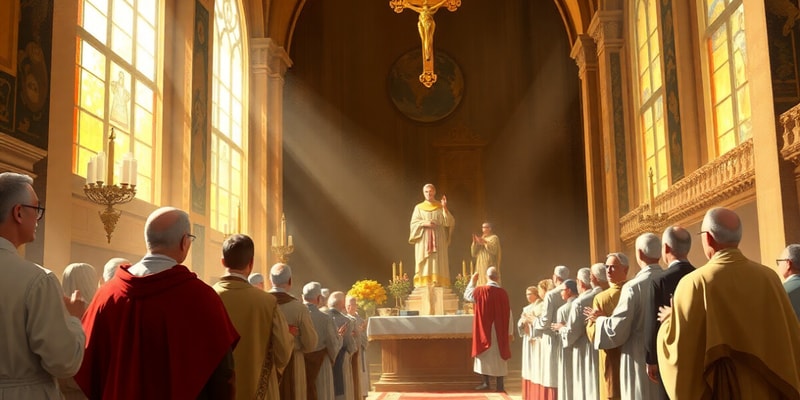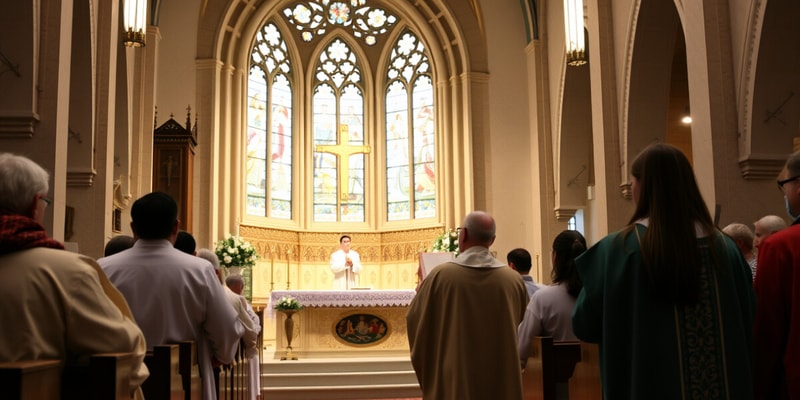Questions and Answers
The primary grace of participation at Mass is unity with Christ, bringing members into communion with one another.
True
The Council of Trent abolished the Latin Mass.
False
The celebration of the Mass saw numerous changes from 1570 until the Second Vatican Council regardless of location.
False
The Second Vatican Council introduced changes to the liturgy that altered the fundamental structure of the Mass.
Signup and view all the answers
The essence of the sacraments in Eastern Catholic Rites differs significantly from the Roman Rite.
Signup and view all the answers
The laity have no significant role in passing on the faith, especially concerning dispelling rumors about Christianity.
Signup and view all the answers
As the Church expanded, local churches, known as parishes, were considered isolated and independent from one another.
Signup and view all the answers
With the legalization of Christianity in the fourth century, the bishops' authority and role were enhanced, not diminished.
Signup and view all the answers
The bishop serves as a representative of the pope in his local diocese.
Signup and view all the answers
Each bishop functions independently and is not part of a larger community of bishops.
Signup and view all the answers
From 1570 until the Second Vatican Council, the structure of the Mass underwent significant changes worldwide.
Signup and view all the answers
The laity are involved in perpetuating and defending the faith by countering misconceptions about Christianity.
Signup and view all the answers
The liturgical practices of the Mass in the Roman Rite during the centuries leading up to the Second Vatican Council were marked by considerable diversity.
Signup and view all the answers
The laity's ability to participate in passing on the faith is not recognized as valuable by the Church.
Signup and view all the answers
Before the Second Vatican Council, the Mass was celebrated in varying languages to accommodate local congregations.
Signup and view all the answers
What are the three parts of the liturgy that highlight the Church's unity?
Signup and view all the answers
Define apostolic succession and its protective role for the Church.
Signup and view all the answers
Identify three abuses in the ministry of bishops that emerged around the second millennium.
Signup and view all the answers
How did the intercessions of the Eucharistic Prayer contribute to the Church's unity?
Signup and view all the answers
Discuss the implications of bishops living outside their dioceses.
Signup and view all the answers
What does the Didache specifically indicate about the Eucharist?
Signup and view all the answers
What was a significant outcome of Pope Benedict XVI's motu proprio in 2007?
Signup and view all the answers
Which two communication methods were essential for maintaining unity among local churches?
Signup and view all the answers
How do church councils differ from synods?
Signup and view all the answers
What role do deacons play in assisting bishops and priests?
Signup and view all the answers
What is the relationship between the college of bishops and the Roman Pontiff, according to the Catechism?
Signup and view all the answers
What title did St. Gregory the Great assign to the papal office?
Signup and view all the answers
Study Notes
Participation in Mass
- The primary grace of participating in Mass is unity with Christ, fostering communion among Church members.
Council of Trent and Mass
- The Latin Mass was established by the Council of Trent.
- From 1570 until the Second Vatican Council, the Mass maintained a consistent form globally.
Changes Post Second Vatican Council
- The Second Vatican Council permitted liturgical revisions, preserving the fundamental structure of the Mass amidst changes.
Eastern Catholic Rites
- The sacraments' essence in Eastern Catholic Rites parallels that of the Roman Rite, with variations in form.
Role of the Laity
- The laity play a vital role in transmitting and defending the faith, countering misconceptions about Christianity and making it appealing to non-Christians.
Local Churches and Parishes
- As the Church expanded, parishes were viewed as interconnected congregations, promoting spiritual communion with other local churches.
Role of Bishops
- Despite the legalization of Christianity in the fourth century, bishops retained significant roles in the Church.
- Bishops function as vicars of Christ within their dioceses rather than merely as representatives of the pope.
- Each bishop belongs to the "college of bishops," signifying unity in the episcopal body.
Mass Celebration and Changes
- From 1570 until the Second Vatican Council, the structure of the Mass experienced minimal changes globally.
- This period signifies a time of uniformity in the celebration of Mass irrespective of geographical differences.
Role of the Laity in Faith
- The laity holds a significant role in passing on and defending the faith.
- Their responsibilities include countering misinformation about Christianity.
- Laity aim to present Christianity as both rational and appealing to non-Christians.
Church Unity in Liturgy
- The intercessions in the Eucharistic Prayer emphasize collective prayer and intention, fostering a sense of community.
- The Lord’s Prayer serves as a universal prayer, uniting congregants in a shared expression of faith.
- Holy Communion is a sacramental act that binds members of the Church, reinforcing togetherness through the sharing of the Eucharist.
Apostolic Succession
- Apostolic succession involves the careful selection and ordination of new bishops by existing bishops in an unbroken line from the original Apostles.
- It safeguards the Church from contemporary, potentially erroneous interpretations of scripture, ensuring theological consistency and fidelity to apostolic teachings.
Abuses in Bishopric Practices
- Bishops were often appointed by secular nobility, focusing on material gains rather than spiritual leadership.
- Many bishops resided outside their dioceses, leading to a disconnect from the needs and concerns of their congregations.
- There was a significant lack of engagement in the daily lives of parishioners, resulting in diminished pastoral care and oversight.
Eucharistic Celebration According to the Didache
- The Eucharist is described as a meal that unites the church as a new people of God, emphasizing community and identity.
Pope Benedict XVI’s Motu Proprio in 2007
- This motu proprio facilitated the celebration of Latin Mass, reflecting a renewed interest in traditional liturgical practices.
Maintaining Unity Among Local Churches
- Letters were utilized to communicate and preserve unity.
- Episcopal synods served as gatherings for bishops to discuss and address communal issues, enhancing cooperation and unity.
Difference Between Church Council and Synod
- A Church council is a formal legislative assembly of church leaders, while synods do not possess legislative authority and focus more on discussion and consultation.
Role of Deacons in Assisting Bishops and Priests
- Deacons play a vital role by distributing Holy Communion, officiating marriages, presiding over funerals, and assisting in various liturgical and pastoral duties.
College of Bishops and Roman Pontiff According to the Catechism
- The Catechism asserts that the college of bishops does not hold authority unless in communion with the Roman Pontiff, highlighting the hierarchical structure of the Church.
Titles in Papal Office
- St. Gregory the Great referred to the papal office with the title "Servant of Servants of God."
- St. John Paul II identified the Pope as the "first servant of unity," underscoring the papal role in fostering church unity.
Importance of the Ministry of the Bishop of Rome
- The Bishop of Rome, or Pope, serves as a symbol of unity within the Church and acts as the principal guarantor of this unity, reinforcing the role's essential nature in the life of the Church.
Studying That Suits You
Use AI to generate personalized quizzes and flashcards to suit your learning preferences.
Description
Test your understanding of the significance of participation in the Catholic Mass and its historical developments. This quiz covers key points from the Council of Trent to the changes introduced by the Second Vatican Council. See how well you know the teachings and traditions of the Church!




